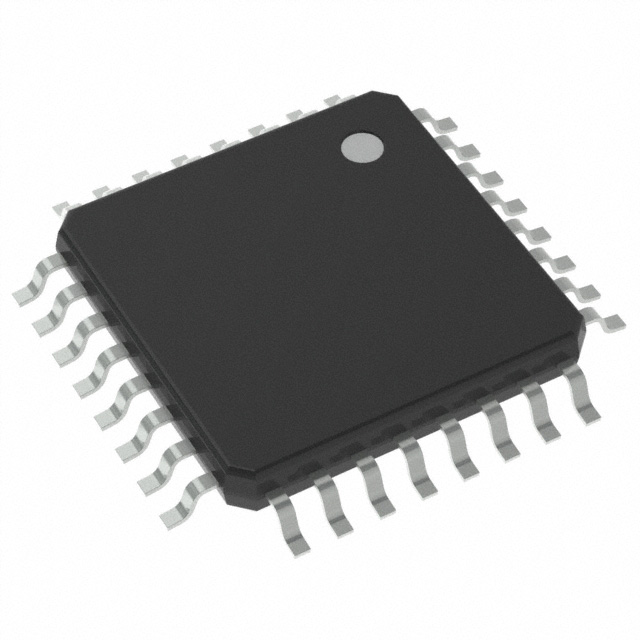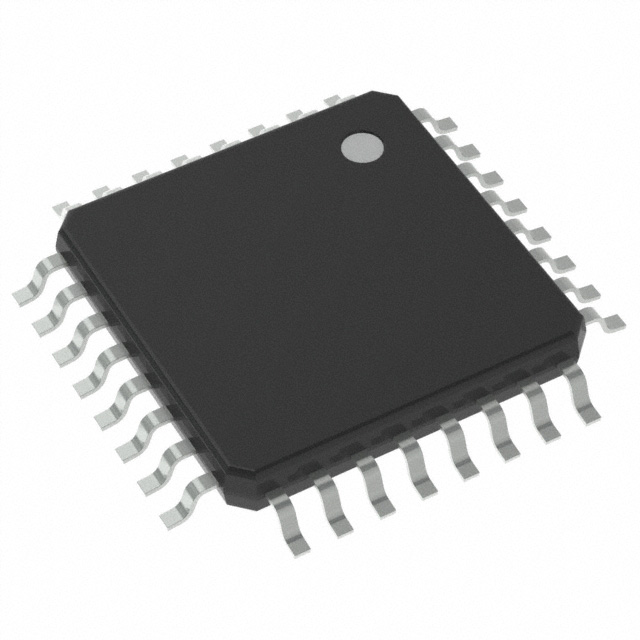Microchip Technology ATMEGA328P-AU
ATMEGA328P-AU Introduction
ATMEGA328P-AU is a high-performance, low-power 8-bit AVR microcontroller launched by Microchip (formerly Atmel), which is widely used in embedded system development. Its rich peripherals and excellent power management capabilities make it one of the most popular models in microcontroller development, especially in Arduino development boards (such as Arduino Uno).
Bootloader and upload to Atmega328P-AU
ATMEGA328P-AU parameters
ATMEGA328P-AU Similar Comparisons
ATMEGA328P-AU vs ATMEGA168A-AU vs ATMEGA168PA-AU vs ATMEGA88A-AU Comparison
| Parameter | ATMEGA328P-AU | ATMEGA168A-AU | ATMEGA168PA-AU | ATMEGA88A-AU |
|---|---|---|---|---|
| Image |  |  |  |  |
| Manufacturer | Microchip Technology | Microchip Technology | Microchip Technology | Microchip Technology |
| Architecture | AVR Advanced RISC | AVR Advanced RISC | AVR Advanced RISC | AVR Advanced RISC |
| Package Type | TQFP32 | TQFP32 | TQFP32 | TQFP32 |
| Flash Memory | 32 KB | 16 KB | 16 KB | 8 KB |
| SRAM | 2 KB | 1 KB | 1 KB | 512 B |
| EEPROM | 1 KB | 512 B | 512 B | 512 B |
| GPIO Pins | 23 | 23 | 23 | 23 |
| ADC Resolution | 10-bit, 6/8 channels | 10-bit, 6/8 channels | 10-bit, 6/8 channels | 10-bit, 6/8 channels |
| Timers/Counters | 2 x 8-bit, 1 x 16-bit | 2 x 8-bit, 1 x 16-bit | 2 x 8-bit, 1 x 16-bit | 2 x 8-bit, 1 x 16-bit |
| Operating Voltage | 1.8V - 5.5V | 1.8V - 5.5V | 1.8V - 5.5V | 2.7V - 5.5V |
| Power Consumption (Sleep Mode) | 0.1 μA | 0.1 μA | 0.1 μA | 0.1 μA |
| Communication Interfaces | SPI, UART, I²C | SPI, UART, I²C | SPI, UART, I²C | SPI, UART, I²C |
| Supported Peripherals | PWM, ADC, RTC | PWM, ADC, RTC | PWM, ADC, RTC | PWM, ADC, RTC |
| Low-Power Mode Support | Yes | Yes | Yes | Yes |
| Operating Temperature | -40°C to +85°C | -40°C to +85°C | -40°C to +85°C | -40°C to +85°C |
| Target Applications | Arduino, IoT, Consumer Electronics | Entry-Level Embedded Systems | Low-Power Embedded Applications | Basic Embedded Controls |
Key Differences
Memory Capacity: ATMEGA328P-AU offers the largest Flash memory (32 KB), ideal for complex applications.
ATMEGA88A-AU has the smallest memory (8 KB), suitable for basic tasks.
Operating Voltage Range: ATMEGA88A-AU operates at a minimum of 2.7V, while the others support as low as 1.8V.
Power Efficiency: ATMEGA168PA-AU provides optimized low-power features, ideal for battery-powered applications.
Application Areas: ATMEGA328P-AU is best for resource-demanding applications such as Arduino-based projects.
ATMEGA88A-AU fits simple and cost-sensitive tasks.
Summary
For projects requiring more memory and flexibility: ATMEGA328P-AU is the best choice.
For medium-sized projects: ATMEGA168A-AU or ATMEGA168PA-AU is suitable.
For cost-sensitive and basic applications: ATMEGA88A-AU is a good option.
ATMEGA328P-AU PDF Datasheet
Main features of ATMEGA328P-AU
High-performance core:
Adopts AVR advanced RISC architecture.
Executes most instructions in a single cycle, supporting processing power of up to 20 MIPS per second.
Rich storage resources:
32 KB Flash for storing program code.
1 KB EEPROM for storing non-volatile data.
2 KB SRAM for dynamic data storage.
Low power design:
Supports multiple power consumption modes (sleep mode, power-down mode, etc.).
Operating voltage range: 1.8V to 5.5V.
Multiple peripheral support:
10-bit ADC: 6 to 8 channels (depending on the package).
Timer/Counter: 2 8-bit and 1 16-bit.
Communication interface: supports SPI, I²C (TWI) and UART.
PWM output: 6 PWM signal support.
ATMEGA328P-AU Package and pin configuration:
ATMEGA328P-AU is packaged as TQFP32 (32 pins).
Compact package, suitable for space-constrained applications.
Compatibility:
Fully compatible with the Arduino platform, rich developer resources.
ATMEGA328P-AU functional advantages
Ease of use:
Supports rich development resources, including official documents and third-party tutorials.
Compatible with the Arduino platform, easy to get started.
High cost performance:
Provides powerful performance and rich functions, suitable for small and medium-sized embedded projects.
Extensive peripheral support:
Rich peripheral interfaces, easy to connect sensors, communication modules and display devices.
Stability:
Reliable operation within industrial temperature range, suitable for harsh environments.
ATMEGA328P-AU Typical Applications
Internet of Things (IoT) devices:
Smart home, environmental monitoring, wireless sensor networks.
Consumer electronics:
Remote controls, toys, smart watches.
Education and development:
Arduino prototype development, electronic design teaching experiments.
Industrial control:
Data loggers, robots, automation control.
ATMEGA328P-AU Development Resources
Development Tools:
IDE: Atmel Studio, Arduino IDE.
Programmer: Supports AVRISP mkII, USBasp, STK500, etc.
Development Board Support:
Arduino Uno uses the ATmega328P series chip for rapid prototyping.
ATMEGA328P-AU FAQ
1. What is ATMEGA328P-AU?
ATMEGA328P-AU is an 8-bit microcontroller based on the AVR architecture, provided by Microchip Technology, with 32 KB of Flash storage, 2 KB of SRAM and 1 KB of EEPROM. It is commonly used in open source hardware platforms such as Arduino UNO.
2. What are the main features of ATMEGA328P-AU?
32 KB Flash storage space, supporting application storage.
10-bit resolution ADC, providing 6 or 8 channels.
23 GPIO pins, supporting a variety of peripheral interfaces (SPI, I²C, UART).
Supports PWM, RTC and multiple low-power modes.
Maximum operating frequency 20 MHz.
Low-power design, power consumption is only 0.1 μA in sleep mode.
3. What are the common applications of ATMEGA328P-AU?
Arduino Development Platform
Internet of Things (IoT) Devices
Home Automation Systems
Consumer Electronics
Industrial Control and Sensor Applications
4. What is the difference between ATMEGA328P-AU and ATMEGA328P-PU?
ATMEGA328P-AU is a TQFP package with the advantage of miniaturization, suitable for PCB soldering and automated assembly.
ATMEGA328P-PU is a DIP package, suitable for breadboard and rapid prototyping.
5. What communication protocols does ATMEGA328P-AU support?
UART (serial communication)
SPI (serial peripheral interface)
I²C (two-wire communication)
6. What is the operating voltage range of ATMEGA328P-AU?
1.8V to 5.5V, suitable for a variety of power supply environments.
7. Does ATMEGA328P-AU support low-power operation?
Yes. ATMEGA328P-AU supports multiple low-power modes (such as sleep mode and power-down mode). In sleep mode, the power consumption can be as low as 0.1 μA, which is very suitable for battery-powered applications.
8. How to program ATMEGA328P-AU?
Use Arduino IDE for programming and burn it with Arduino UNO compatible development board through USB-TTL converter.
Or program it directly through Atmel Studio using AVRISP mkII or other programming tools.
9. What is the maximum operating frequency of ATMEGA328P-AU?
The maximum operating frequency is 20 MHz.
10. How to judge whether ATMEGA328P-AU is suitable for my project?
If you need:
A reliable low-power microcontroller;
Simple and powerful hardware interface support;
Compatible with Arduino development platform;
Small package suitable for dense PCB design,
then ATMEGA328P-AU is a very good choice.
Microchip
Запасы : 36489






